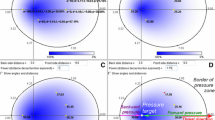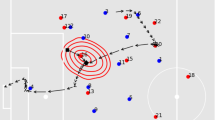Abstract
Current technologies allow movements of the players and the ball in football matches to be tracked and recorded with high accuracy and temporal frequency. We demonstrate an approach to analyzing football data with the aim to find typical patterns of spatial arrangement of the field players. It involves transformation of original coordinates to relative positions of the players and the ball with respect to the center and attack vector of each team. From these relative positions, we derive features for characterizing spatial configurations in different time steps during a football game. We apply clustering to these features, which groups the spatial configurations by similarity. By summarizing groups of similar configurations, we obtain representation of spatial arrangement patterns practiced by each team. The patterns are represented visually by density maps built in the teams’ relative coordinate systems. Using additional displays, we can investigate under what conditions each pattern was applied.
You have full access to this open access chapter, Download conference paper PDF
Similar content being viewed by others
Keywords
These keywords were added by machine and not by the authors. This process is experimental and the keywords may be updated as the learning algorithm improves.
1 Introduction
Current tracking technologies enable measuring and recording of the spatial positions and movements of the players and the ball in football (a.k.a. soccer) games with high accuracy and temporal frequency. Analysis of the resulting trajectories can bring valuable knowledge about the movement behaviors of the players and teams and interactions between the players and between the teams. A lot of research has been done on analyzing various aspects of a football game, such as players’ performance (e.g. [4]), passes (e.g. [3]) and pass opportunities (e.g. [5]), team formations (e.g. [2]), and others. Analysis of formations mostly focuses on identifying long- and short-term roles of individual players [2] or typical geometric configurations of tactical groups [6].
We demonstrate a novel approach to analyzing collective movement behaviors of football teams with the aim to find typical patterns of spatial arrangement of all field players within their teams and in relation to the opponent teams. For this purpose, we transform the positions of the players in the field into their relative positions with respect to the centers and attack vectors of the teams and analyze the distributions of the players in these “team spaces” (similarly to [1]).
2 Characterization and Analysis of Spatial Configurations
We use the term spatial configuration for the relative arrangement of the field players in one time moment. A spatial configuration can be characterized by the coordinates of the players in “team spaces”. The team space of one team is defined in each moment by the team centroid (i.e., the mean position of all field players of this team) and the direction towards the opponents’ goal (attack direction). The team centroid is taken as the origin of the coordinates. The vertical axis of the team space corresponds to the attack direction, and the horizontal axis is perpendicular to it. Such coordinate system is created for each team. For each moment of the game, the positions of the players of both teams and the positions of the ball are transformed to the coordinate system of each team. The horizontal coordinate shows the relative position in the left or right side of the team, and the vertical coordinate shows the relative position in the back or front side of the team.
The transformation is illustrated in Fig. 1 by example of trajectories of two players from opposing teams (black and green). Figure 1A shows the original trajectories in the space of the pitch. The goal of the black team is on the left and the goal of the green team is on the right. The attack directions of the teams are indicated by colored arrows at the bottom of the image. In Fig. 1B, the trajectories are composed from the relative positions of the players in their own teams. The image represents simultaneously the spaces of both teams, i.e., their coordinate systems are aligned. We see that, despite quite strong separation of the two trajectories in the field space (Fig. 1A), they cover similar regions in their team spaces, i.e., they have similar roles in their teams. Image 1C represents the space of the black team. The green trajectory shows how the green team player was positioned in relation to the opponent team. Likewise, image 1D represents the space of the green team and the positioning of the black team player with respect to the opponents.
To find typical patterns of spatial arrangement, which is the goal of our analysis, we need to group the spatial configurations that occurred throughout the game by similarity. This can be achieved by means of clustering. To apply clustering, we need to represent the spatial configurations by appropriate features. We construct feature vectors of the spatial configurations by putting the players’ relative positions in the team spaces in the order of decreasing vertical coordinates, i.e., from front to back. To reduce the sensitivity of the descriptions of the spatial configurations to substitutions of players and changes of players’ roles, we apply ordering from left to right when the vertical difference is below a threshold (e.g., 2 m).
The full feature vector of a spatial configuration consists of the coordinates of the field players of each team in their own team space and in the team space of the opponents plus the coordinates of the ball in the spaces of both teams. On demand, a subset of features can be used for clustering, e.g., features of only one team.
By summarizing the clusters of spatial configurations produced by a clustering algorithm (e.g., k-means or EM), we obtain a representation of typical spatial arrangement patterns. Since each spatial configuration is basically a set of points (which represent players’ positions), we summarize a cluster of configurations by computing joint point density fields in the team and field spaces using kernel density estimation.
In the demonstration, we show interactive clustering of spatial configurations and visual exploration of spatial arrangement patterns supported by interactive tools.
3 Example
In this example, we use data collected during the German Bundesliga game of Borussia Dortmund against VfL Wolfsburg on 10/12/2015. Our analysis focus is the arrangement patterns of the field players of Dortmund in relation to the opponents. For clustering, we use a subset of features consisting of the relative positions of the Dortmund’s players in the space of Wolfsburg. Figure 2 shows the results for k-means clustering with k = 8. The density maps represent the Dortmund’s configuration patterns in the Wolfsburg’s team space. Here we use a color scale from light blue for low densities to red for high densities. The movements of the ball during the times when the configurations took place are represented by semi-transparent black lines.
To investigate in what conditions these different arrangement patterns were applied, we use additional displays. Thus, Fig. 3 shows how the patterns are related to the ball possession. The lengths of the green and red bars represent the numbers of time moments when the ball was possessed by Wolfsburg (green) and Dortmund (black). The uppermost pair of bars correspond to the whole game, excluding the time when the ball was out of play. The remaining rows correspond to the clusters of the spatial configurations. We see that the pattern of cluster 1 was used almost exclusively under ball possession by Dortmund, whereas the patterns of clusters 5 and 6 were mostly applied under ball possession by Wolfsburg. The remaining patterns are not so clearly related to the ball possession by either of the teams. In Fig. 4, we see how the patterns are related to the positions of the Dortmund’s players and the ball in the field.
References
Andrienko, N., Andrienko, G., Barrett, L., Dostie, M., Henzi, P.: Space transformation for understanding group movement. IEEE Trans. Vis. Comput. Graph. 19(12), 2169–2178 (2013)
Bialkowski, A., Lucey, P., Carr, P., Yue, Y., Sridharan, S., Matthews, I.A.: Large-scale analysis of soccer matches using spatiotemporal tracking data. In: IEEE ICDM 2014 (International Conference on Data Mining), pp. 725–730. IEEE (2014)
Cintia, P., Rinzivillo, S., Pappalardo, L.: A network-based approach to evaluate the performance of football teams. In: Machine Learning and Data Mining for Sports Analytics Workshop, Porto, Portugal (2015)
Di Salvo, V., Baron, R., Tschan, H., Calderon Montero, F., Bachl, N., Pigozzi, F.: Performance characteristics according to playing position in elite soccer. Int. J. Sports Med. 28(3), 222–227 (2007)
Gudmundsson, J., Wolle, T.: Football analysis using spatio-temporal tools. Comput. Environ. Urban Syst. 47, 16–27 (2014)
Perl, J., Grunz, A., Memmert, D.: Tactics analysis in soccer: an advanced approach. Int. J. Comput. Sci. Sport 12(1), 33–44 (2013)
Author information
Authors and Affiliations
Corresponding author
Editor information
Editors and Affiliations
Rights and permissions
Copyright information
© 2016 Springer International Publishing AG
About this paper
Cite this paper
Andrienko, G., Andrienko, N., Budziak, G., von Landesberger, T., Weber, H. (2016). Coordinate Transformations for Characterization and Cluster Analysis of Spatial Configurations in Football. In: Berendt, B., et al. Machine Learning and Knowledge Discovery in Databases. ECML PKDD 2016. Lecture Notes in Computer Science(), vol 9853. Springer, Cham. https://doi.org/10.1007/978-3-319-46131-1_6
Download citation
DOI: https://doi.org/10.1007/978-3-319-46131-1_6
Published:
Publisher Name: Springer, Cham
Print ISBN: 978-3-319-46130-4
Online ISBN: 978-3-319-46131-1
eBook Packages: Computer ScienceComputer Science (R0)








